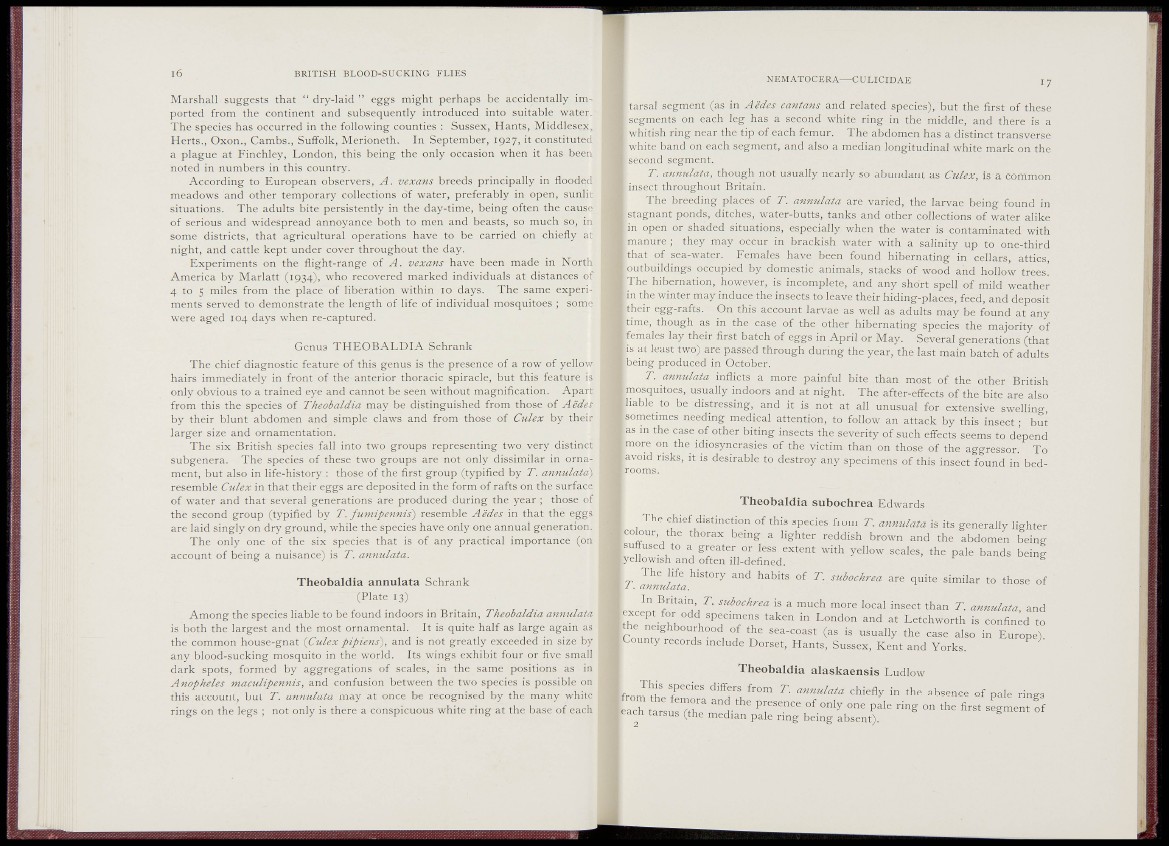
16 BRITISH BLOOD-SUCKING FLIES
NEMATOCERA—CULICIDAE 17
Marshall suggests that " dry-laid " eggs might perhaps be accidentally imported
from the continent and subsequently introduced into suitable water.
The species has occurred in the following counties : Sussex, Hants, Middlesex.
Herts., Oxen., Cambs., Suffolk, Merioneth. In September, 1927, it constituted
a plague at Finchley, London, this being the only occasion when it has been
noted in numbers in this country.
According to European observers, A. vexans breeds principally in flooded
meadows and other temporary collections of water, preferably in open, sunlit
situations. The adults bite persistently in the day-time, being often the cause
of serious and widespread annoyance both to men and beasts, so much so, in
some districts, that agricultural operations have to be carried on chiefly at
night, and cattle kept under cover throughout the day.
Experiments on the flight-range of A. vexans have been made in North
America by Marlatt (1934), who recovered marked individuals at distances of
4 to 5 miles from the place of liberation within 10 days. The same experiments
served to demonstrate the length of life of individual mosquitoes ; some
were aged 104 days when re-captured.
Genus THEOBALDIA Schrank
The chief diagnostic feature of this genus is the presence of a row of yellow
hairs immediately in front of the anterior thoracic spiracle, but this feature is
only obvious to a trained eye and cannot be seen without magnification. Apart
from this the species of Theobaldia may be distinguished from those of Aedes
by their blunt abdomen and simple claws and from those of Culex by their
larger size and ornamentation.
The six British species fall into two groups representing two very distinct
subgenera. The species of these two groups are not only dissimilar in ornament,
but also in life-history ; those of the first group (typified by T. annulatd)
resemble C^dex in that their eggs are deposited in the form of rafts on the surface
of water and that several generations are produced during the year ; those of
the second group (typified by T. fumipennis) resemble Aedes in that the eggs
are laid singly on dry ground, while the species have only one annual generation.
The only one of the six species that is of any practical importance (on
account of being a nuisance) is T. annulata.
Theobaldia annulata Schrank
(Plate 13)
Among the species liable to be found indoors in Britain, Theobaldia an7iulata
is both the largest and the most ornamental. It is quite half as large again as
the common house-gnat {Culex pipiens), and is not greatly exceeded in size by
any blood-sucking mosquito in the world. Its wings exhibit four or five small
dark spots, formed by aggregations of scales, in the same positions as in
Anopheles maculipennis, and confusion between the two species is possible on
this account, but T. annulata may at once be recognised by the many white
rings on the legs ; not only is there a conspicuous white ring at the base of each
tarsal segment (as in Aedes cantans and related species), but the first of these
segments on each leg has a second white ring in the middle, and there is a
whitish ring near the tip of each femur. The abdomen has a distinct transverse
white band on each segment, and also a median longitudinal white mark on the
second segment.
T. annulata, though not usually nearly so abundant as Culex, is a common
insect throughout Britain.
The breeding places of T. annulata are varied, the larvae being found in
stagnant ponds, ditches, water-butts, tanks and other collections of water alike
in open or shaded situations, especially when the water is contaminated with
manure ; they may occur in brackish water with a salinity up to one-third
that of sea-water. Females have been found hibernating in cellars, attics,
outbuildings occupied by domestic animals, stacks of wood and hollow trees.'
The hibernation, however, is incomplete, and any short spell of mild weather
in the winter may induce the insects to leave their hiding-places, feed, and deposit
their egg-rafts. On this account larvae as well as adults may be found at any
time, though 3.S in the C3.SG of" the other hibcmâtino' spccies the ni3.jority of
females lay their first batch of eggs in April or May. Several generations (that
is at least two) are passed through during the year, the last main batch of adults
being produced in October.
T. annulata inflicts a more painful bite than most of the other British
mosquitoes, usually indoors and at night. The after-effects of the bite are also
liable to be distressing, and it is not at all unusual for extensive swelling
sometimes needing medical attention, to follow an attack by this insect ; but
as m the case of other biting insects the severity of such effects seems to depend
more on the idiosyncrasies of the victim than on those of the aggressor. To
avoid risks, it is desirable to destroy any specimens of this insect found in bedrooms.
Theobaldia subochrea Edwards
The chief distinction of this species from T. a^inulata is its generally lic^hter
colour, the thorax being a lighter reddish brown and the abdomen beinsuffused
to a greater or less extent with yellow scales, the pale bands being
yellowish and often ill-defined. ^
The life history and habits of T. subochrea are quite similar to those of
1. annulata.
In Britain, r . subochrea is a much more local insect than T. annulata, and
except for odd specimens taken in London and at Letchworth is confined to
the neighbourhood of the sea-coast (as is usually the case also in Europe).
County records include Dorset, Hants, Sussex, Kent and Yorks.
Theobaldia alaskaensis Ludlow
fronithe f f " ' ' chiefly in the absence of pale rings
ach tarsu The' r ' eacn tarsus (the median pale ring being absent^)^. ^^ ^^ ^^^ ^ ^ ^ ^ ^ - - t of